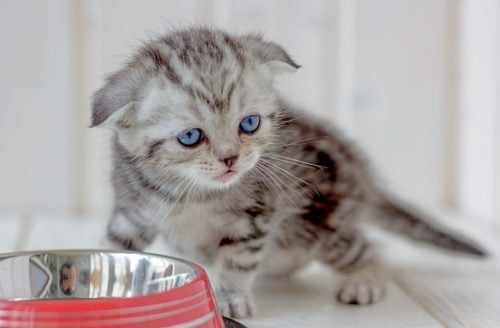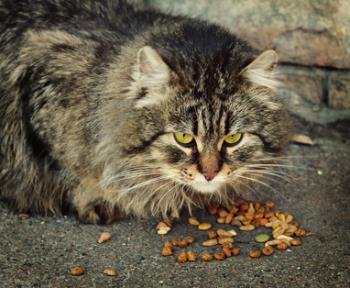We’ve brought this topic up in other articles, but it’s something that we’ve seen many patients bring their cat in with a urinary tract infection for. We’ve talked about the possible actions to take if your cat does not drink enough water as well as how to avoid and treat dehydration in cats. A less common but still dangerous situation occurs when a cat starts to drink more water, but this additional drinking goes unnoticed by the cat’s owner. Do you think your cat drinks too much water? Do you understand the implications of your cat’ excessive thirst?

In this article, you’ll learn the signs of illness for your cat drinking a lot of water, how much your cat should be drinking, and what to do if this starts to happen.
Table of Contents
My cat is drinking a lot of water, should I be concerned?
IMPORTANT: If you notice your cat drinking more water than usual, please visit your veterinarian as soon as possible.
We also want to encourage all you pet parents to pay attention to their cats’ water drinking habits. Especially if you have an older cat.
In our field of veterinary medicine, drinking excessive amounts of fresh water is known as polydipsia. There is a link between polydipsia and numerous other medical conditions. Some of the most common diseases and their symptoms are:
- Diabetes. Excessive thirst is one of the early signs of diabetes in cats. Diabetes in cats is the same as in dogs and humans where the patients blood sugar levels are elevated. This medical condition is usually accompanied by sudden weight loss which is soon replaced by weight gain. It’s a very specific pattern. Even if other diabetes symptoms such as excessive urination and increased appetite do not present, please talk to your veterinarian immediately.
- Renal Failure. Your cats kidneys are part of their renal system which filters out the toxins in their bloodstream, regulate blood pressure, and the production of urine. Renal failure is also known as chronic kidney disease. This is when the kidneys no longer perform these functions which is a serious medical concern. Signs of kidney disease include defecating and vomiting blood, lethargy, anorexia, and a few more. Other signs of kidney failure that may be present are diarrhea and vomiting.
- Hyperthyroidism. This condition is known as hyrotoxicosis. It’s the most common disease in cats, especially older cats. This is where the thyroid gland in your cat’s neck over produces the thyroid hormone. Common signs to look for are weight loss, increased appetite, vomiting, diarrhea, poor body condition, and an enlarged thyroid gland (in their neck).
There may be other health conditions related to increased thirst in cats such as urinary tract disease and liver disease. But for the purposes of this article, we want to focus on excessive drinking. The most important point to note is this: if you notice excessive water intake in your cat, take him or her to your veterinarian immediately. They may take or ask for urine sample to do a urine test to help with their diagnosis.
Thankfully, any of the diseases mentioned above can be efficiently managed or treated if they are diagnosed early. Your veterinarian may also order blood tests to identify the cause of your cat’s excessive thirst.
How do you know if your cat is drinking too much water?

Next comes the question of whether your beloved cat is drinking water too much. How do you know if your cat’s water intake is excessive?
First, the most important thing you have to do is monitor how much your cat drinks. Don’t just replace and add to your cat’s water bowl. You’ll want to monitor the water levels in their dish and pay attention to how much it reduces during the day. NOTE: If where you live has low humidity and/or has dry air from constant air conditioning, you should keep in mind that some, maybe even a large amount may be lost to evaporation from their water dish.
But how much water should a cat drink, and how much is too much? “The 5-minute veterinary consult” states that polydipsia is the greater than normal consumption of water. Normal consumption is defined as more than 45 milliliters per kilogram or 4 ounces per 5 pounds of body weight. NOTE: This also includes water your cat receives in their food. So consider this you have your cat on a wet food diet.
How to calculate how much water your cat should drink
A cat requires a total of 44 to 66 ml of water per kilogram of body weight (or 0.67 to 1 oz. per pound) each day.
(source: “Feline behavior for veterinarians” second edition, B. V. Beaver, 2003)
Calculation Example:
Let’s say that we have a cat weighing 5 kg (11 lbs.). This cat’s minimum daily water requirement using the above formula, is 220 ml (7.4 oz.).
As mentioned before, this also includes water that your cat receives in their food. Most dry food contains no more than 10% moisture while canned cat food diets may consist of up to 80% water content. What this means is that your cat’s diet can significantly affect how much he or she should drink. Look at the label of the wet cat food. In the nutrition information, it should say how much moisture it has.
How much water should a cat drink per day?

Here are the approximate amounts of water provided by daily amounts of dry and wet food:
- 2 ounces of dry food provides 1/5 of an ounce of water. This means that our example cat of 10 pounds must drink an additional almost 8 ounces of water. That’s almost a full cup of water per day for a dry food diet.
- The average 5 ounce can of wet food provides 4-5 ounces of water. Therefore our fictitious cat of 10 pounds should drink only 3 ounces of water per day. That is slightly more than 2 tablespoons, which is very, very little.
What should you do if your cat is drinking excessively?
Please don’t lose yourself in calculations. It’s best if you can look after your cat’s water consumption habits and other behaviors over the long run. That way you can quickly notice and be on alert if things begin to change. The key here is “change”. Meaning, your cat’s intake changes which is when you should be on the alert. You can learn more about your cat’s water needs here.
The best advice we offer to our patients is this. In case you notice that your cat has noticeably increased their daily water intake, please visit your veterinarian. Note any other changes in your cats behavior such as increased urination, urinating or defecating outside their litter box, increased appetite, digestive problems like diarrhea, weight loss, coat issues, etc. Make sure you highlight the details of these and your cats drinking habits to your veterinarians attention. Early diagnosis of any disease will get you many steps ahead of the starting line when you need to take actions to ensure your cat stays healthy. The same rule goes for your dog if you have one.
You have learned the signs of illness for your cat drinking a lot of water, how to calculate how much water your cat should be drinking, and what to do if it’s excessive. With this knowledge, you can watch for any developing problems and keep your cat healthy. This will go a long way towards a healthy and happy life together for you and your pet cat. And keeping your Pet happy is what we all want.
FAQ
Question: My cat is drinking a lot of water, should I be concerned?
Answer: Yes. You should be concerned if your cat is drinking more water than usual. Excessive thirst can be a sign of a serious medical condition.
Question: How do I know if my cat is drinking too much water?
Answer: Monitor how much water your cat drinks in a day. If your cat is drinking more than 4 ounces of water per 5 pounds of body weight, they may be drinking too much.
Question: What should I do if my cat is drinking excessively?
Answer: Take your cat to your veterinarian for a checkup. Your veterinarian will be able to determine if your cat has an underlying medical condition and if so, recommend the appropriate treatment.
Question: What are some of the health conditions that can cause excessive thirst in cats?
Answer : Diabetes, kidney disease, hyperthyroidism, urinary tract infection, liver disease are the most common.
Question: What are some of the signs and symptoms of these health conditions?
Answer: Excessive thirst, increased urination, weight loss, vomiting, diarrhea, lethargy, poor appetite, and changes in behavior.
Question: How much water should a cat drink per day?
Answer: 4 ounces per 5 pounds of body weight. This includes moisture contained in the food they are fed.
